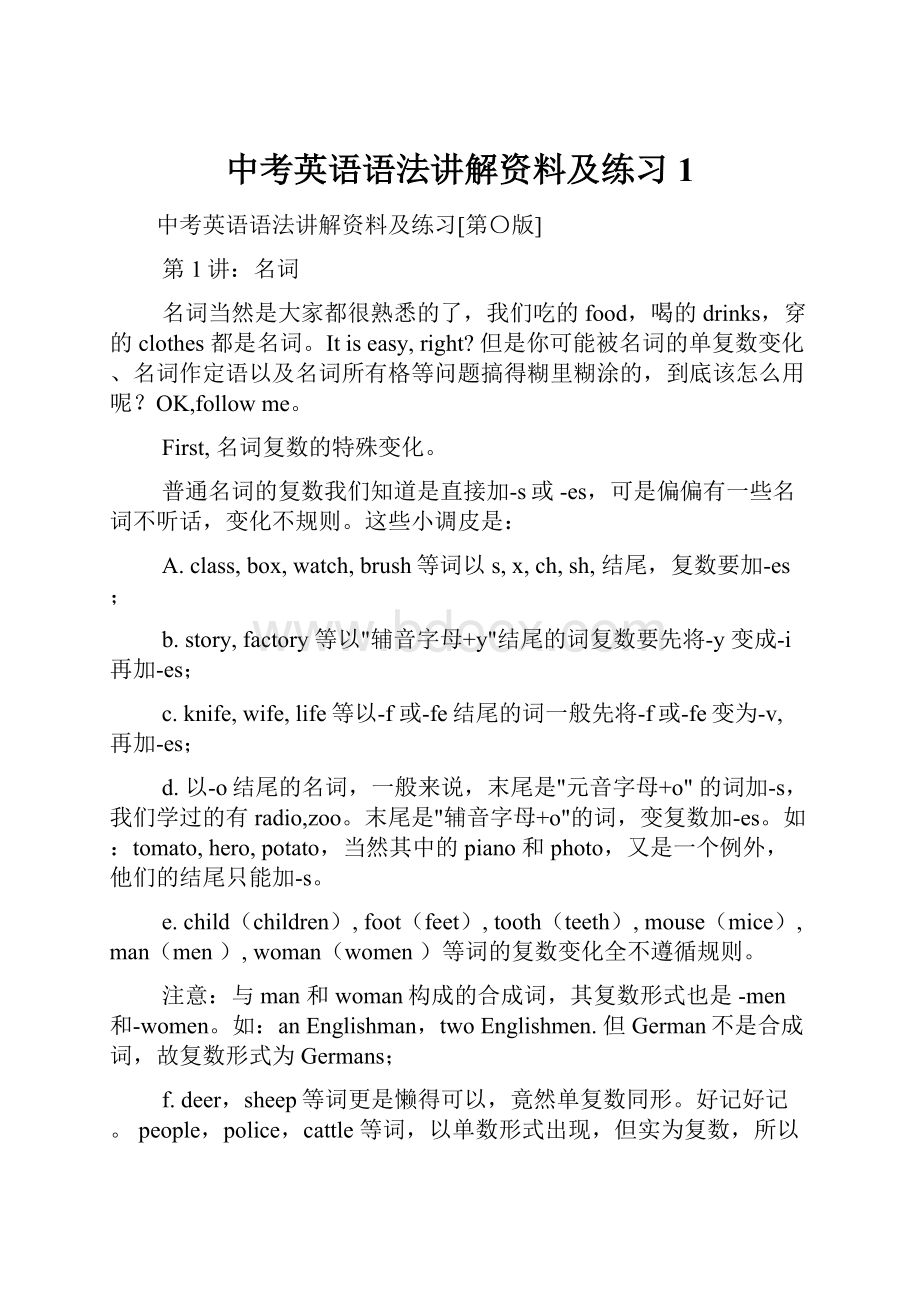中考英语语法讲解资料及练习1Word文件下载.docx
《中考英语语法讲解资料及练习1Word文件下载.docx》由会员分享,可在线阅读,更多相关《中考英语语法讲解资料及练习1Word文件下载.docx(73页珍藏版)》请在冰豆网上搜索。

别奇怪,名词有时也可以作定语的。
它作定语时一般用单数,但也有以下例外。
A.man,woman等作定语时,它的单复数以其所修饰的名词的单复数而定。
men workers,womenteachers。
b.数词+名词作定语时,这个名词一般保留单数形式,中间加连字符。
aten-milewalk十里路,two-hundredtrees两百棵树。
哇!
这些问题好复杂,我好想轻松一下。
那我们就轻轻松松地面对名词所有格问题。
这里面内容可谓少之又少,可也不能小视呦。
名词所有格:
表示“……的”通常是在名词的后面加-s,如:
Children'
sday,father'
sshoes。
但以-s结尾的名词因为已经有s了,只需加'
就OK了。
如果两个名词并列,并且分别有'
s,.则表示“分别有”。
.如:
John'
sandMary'
srooms(约翰和玛丽各有一间,共两间);
两个名词并列,只有一个'
s,则表示"
共有"
。
JohnandMary'
sroom(约翰和玛丽共有一间)。
还有些无生命名词的所属要用介词of来帮助一下,如:
amapofChina,theendofthisterm。
好,名词部分我们已经学完,It'
sapieceofcake?
接下来到了我们趁热打铁的时间了,
Areyouready?
练习:
1.Allthe_____teachersand______studentsarehavingameetingthere.
A.women…girls B.women…girl C.woman…girls D.woman…girl
2.MrBlackisafriendof_________.
A.Jack'
saunt'
s B.Jack'
saunt C.Jackaunt'
s D.aunt'
sofJack
3.Thistoywasmadebya____boy.
A.ten-year-old B.ten-years-old C.ten-year-older D.ten-years-older
4.Thefarmerraisedten_________.
A.sheeps B.deers C.horse D.cows
5.Shelookedatussadlywithhereyesaslargeas_________.
A.hergrandmotherB.hergrandmother'
sC.hergrandmothers'
D.thatofhergrandmother
6.Wehavemovedintoa________.
A.two-storeyhouseB.houseoftwostoreyC.two-storeyshouseD.twostoreyshouse
7.The______wastoomuchforthechildtocarry.
A.box'
ssteelB.boxofasteelC.steelboxD.boxofthesteel
8.We'
llgiveourEnglishteacheracardfor_________.
A.theTeacher'
sDayB.Teacher'
sDayC.aTeacher'
sDayD.Teachers'
Day
9.LiPingmetanoldfriendof_______onatrainyesterday.
A.he B.him C.his D.her
10._________arebigandbright.
A.TheclassroomwindowB.Thewindowoftheclassroom
C.Thewindowsoftheclassroom D.Theclassroom'
swindows
实战:
1.Don'
tworry.Yoursonwillcomebackin______hour.
A.a B.an C.the D./
2.Thisniceblouseisn'
tmine.It'
s______.
A.you B.your C.Lucy D.yours
3.What'
s"
potato"
inChinese?
-It'
s_____.
A.香蕉 B.大白菜 C.西红柿 D.土豆
4.Theninthmonthofayearis_______.
A.December B.November C.September D.October
5.A:
MustIleavenow?
B:
No,you_______.
A.needn'
t B.mustnt C.don'
t D.won'
t
6.Wehaveahistorylesson______Wednesdayafternoon.
A.on B.of C.at D.to
7.Suanhasmadequite______friendssinceshecametoChina.
A.few B.afew C.little D.alittle
8.A:
Haveyouever______totheWestLake?
B:
Yes,I______therelastwinter.
A.gone,went B.been,went C.gone,havebeen D.been,have
9.Doyou________English?
A.tell B.say C.talk D.speak
10.A:
MayI_______yourruler?
B:
OK,I'
mgladto_______ittoyou.
A.lend,borrow B.lend,lend C.borrow,lend D.borrow,borrow
11.We'
llgotothemuseumifit_______tomorrow.
A.can'
train B.won'
train C.don'
train D.doesn'
trian
12.Doyouknow________?
A.wheredoeshestudy B.hestudieswhere C.wherehestudies D.hewherestudies
13.A:
_______doyougotoseeyourgrandparents?
B:
Onceamonth
A.Howoften B.Howlong C.howmuch D.howmany
14.A:
Wouldyoulikeanothercupoforange?
______I'
mfull.
A.No,thanks B.Yes,please. C.Hereitis. D.Idon'
tlike.
15.Youmustbetired.Whynot________arest?
A.tostoptohave B.stophaving C.stoptohave D.tostophaving
第2讲:
代词
我们刚刚讲完了名词,现在再来看看名词的brother—代词。
它与名词的作用其实很相似,所担当的句中成分也相差不多。
但也别小看代词呀!
它还有很多的“小个性”呢!
只要抓住它的几个“小脾气”,那么你就可以牢牢地掌握它了。
代词中第一个“小个性”就是物主代词。
像my和mine这两个小冤家总是让人分不清谁是谁。
但你只要记住它们最重要的区别—my的后面一定要接名词,不可以单独出现,只能做定语,如:
myfather;
而mine则是名词性,只能单独出现,在句中做主语和表语。
Mineisgreen.It'
smine.记住这两个句子,凡是名词性物主代词(yours,hers,his,its,ours,theirs)就都可以放在mine的位置上了。
这样,通过它们出现的位置不同,我们就可以把它们区别开了。
代词的第二个“罗嗦”就是它有一个小跟班-self(selves)—反身代词,也就是表示“自己、亲自”的意思。
关于反身代词,需要注意的是她不能单独做主语,但可以放在人称代词后面,做同位语。
Marryherselfsaidso.玛丽她自己这么说的。
(不能说Herselfsaidso.)下面我给你开点小灶,单独讲一讲须“特特”注意的地方。
Of+名词性物主代词:
of+物主代词构成双重所有格。
公式为:
a(an,this,that)+名词+of+名词性物主代词。
牢记公式,举一反三。
因为物主代词不可与a,an,this,that,these,those,some,any,no,each,every,such,another等词一起前置,修饰一个名词,而必须用双重所有格。
afriendofmine(我的一个朋友),eachbrotherofhis(他的每一个兄弟). some,any的用法:
我们都知道some用于肯定句中,而any则用于否定句和疑问句中。
所以somebody,someone也用于肯定句中,而anybody、anyone则用于否定和疑问句中。
在Wouldyoulikesomecoffee?
(要来点咖啡吗?
)这样的肯定疑问句中,说话人认为对方的答案会是肯定的,或期望得到肯定回答时,用some而不用any。
every和each的用法:
every强调全体的概念,指三个以上的人或物(含三个),不可单独使用;
each强调个体概念。
指两个以上的人或物(含两个),可单独使用.。
Everystudentinourschoolworkshard.(我们学校的学生都很用功。
)Eachstudentmayhaveonebook..(每个学生都可有一本书。
)
both,either,neither的用法:
both意为“两者全都”,与复数连用。
either意为“两者中间的任何一个”,neither表示“两者之间一个也不是”,与单数连用。
BothofthethemcomefromLondon。
他们两人都是伦敦人。
Youmaytakeeitherwithyou。
两个中间你随便带哪个都行。
Neitheriscorrect。
两个都不对。
Few,afew和little,alittle的用法:
Few,afew用来代替和修饰可数名词,little,alittle用来代替和修饰不可数名词;
afew和alittle着重肯定意思,相当于汉语“有几个”,“有一点儿”;
few和little着重否定意思,相当于汉语“没有几个”,“没有多少”见下表
肯定
否定
可数
Afew
Few
不可数
Alittle
little
OK,代词部分我们已经学完,It'
1.Wehadplentyofpaperbut______ink.
A.afew B.few C.notmany D.notmuch
2.Learningaforeignlanguageisespeciallydifficultforthosewhohaveneverlearned____before.
A.one B.it C.them D.that
3.We'
reverybusybecausewe'
veso_____bookstoreadandso_______homeworktodoeveryday.
A.much...many B.many...much C.many...alot D.alot...much
4.Ithought______ofthematterbutstillcouldn'
tfindoutthereason.
A.every B.both C.nothing D.everything
5.Mycarisnotsoexpensiveas________.
A.him B.he'
s C.he D.his
6.LilyandLucyhavearrived,but_______studentsaren'
thereyet.
A.other B.others C.theother D.theothers
7.Therearehighbuildingson______sideofthestreet.
A.both B.every C.any D.either
8.-Whatdoyouusuallyhaveforbreakfast?
-______eggsand______milk.
ALittle...afew B.Alittle...alittle C.Afew...alittle D.Afew...afew
9.______isdifficultintheworldifyouputyourheartintoit.
A.Something B.Anything C.Nothing D.Everything
10.Isthisstorythesameas______inthatbook?
A.theone B.what C.that D.it
1.Thereis_________oldwomaninthecar.
A.不填 B.the C.a D.an
2.Weoftengotothepark_______Sundays.
A.on B.in C.at D.from
3.Mybook________onthedesk.
A.is B.am C.are D.be
4.Whichlanguageis________,English,FrenchorChinese?
A.difficultB.thedifficult C.moredifficult D.themostdifficult
5.-________bookisthis?
-It'
sKate'
s.
A.when B.Why C.Where D.whose
6.-CanyouwritealetterinEnglish?
-No,I_____.
A.maynot B.mustn'
t C.can'
t D.needn'
7.I________myhomeworkwhenMikecamelastnight.
A.doB.wasdoing C.amdoing D.havedone
8.Hebeganto________Englishthreeyearsago.
A.learn B.learns C.learned D.learning
9.Jimisadriver,_______he?
A.does B.doesn'
t C.is D.isn'
10."
What'
swrong_________you?
"
thedoctorasked.
A.from B.with C.for D.at
11.Heisrich,________heisn'
thappy.
A.orB.soC.and D.but
12.-WhereisAlice?
-She__________tothelibrary.
A.goes B.willgo C.hasgone D.hadgone
13."
Help_________tosomefish,Mary."
Myauntsaidtome.
A.themselves B.ourselves C.yourself D.himself
14.We'
llstayathomeifit________tomorrow.
A.rain B.rains C.israining D.willrain
15.Thestudents_________onafarmfortendays.Thenthey_________toafactory.
Thoughthey_______backschool,theystillrememberthosefarmersandworkers.
A.havestayed,went,was B.hadstayed,go,are
C.havestayed,go,havebeen D.havestayed,went,were
第3讲:
形容词
Springiscoming.Thetreesaregreen,andtheflowersarebeautiful.
多么美的季节啊!
我们要去郊游,去感受、去描绘我们周围美好的事物。
形容词会帮你忙。
可是形容词怎么使用起来老出错呀?
不是放错了位置,搞错了级别,就是在使用多个形容词作定语时排错了顺序。
当然了,形容词使用时需要遵循一些规则的。
想知道吗?
接着往下看。
abeautifullittlenewwhitewoodenhouse从这个长长的词中可以看出多个形容词作
定语时排列有一定的先后顺序。
它们往往遵循以下规律:
冠词或人称代词所有格+数词+性质+大小+形状+表示老少、新旧+颜色+事物质地、人的国籍、用途。
其实,你大可不必这样费神记,只要记住我给你的句子就可以了。
Thereissomethingwrongwithmybike。
这句话可能让你挠挠头皮,为什么wrong放在something的后面呢?
原来虽然大部分形容词做定语时的位置是放在名词之前的,但当形容词所修饰的词为something,anything,nothing,everything等以-thing为字尾的词语(复合不定代词)时,形容词要后置。
形容词级别问题:
A.Ourclassroomistwicelargerthantheirs。
(我们的教室是他们的两倍。
)这种表示倍数的句子用…times+形容词比较级+than…这样的格式。
你记住了吗?
b.I'
mthreeyearsolderthanyou.(我比你大三岁。
)表示"
大三岁,"
高二厘米"
等时用"
表示数量词的词+比较级"
c."
越来越……"
用"
比较级+and+比较级"
来表示。
Theearthisgettingwarmerandwarmer。
(地球变得越来越暖和。
)
d."
越……就越……"
the+比较级…,the+比较级…"
Thebusierheis,thehappierhefeels。
(他越忙,越觉得高兴。
最高级用法的用法就很简单了,提醒你一点,最高级